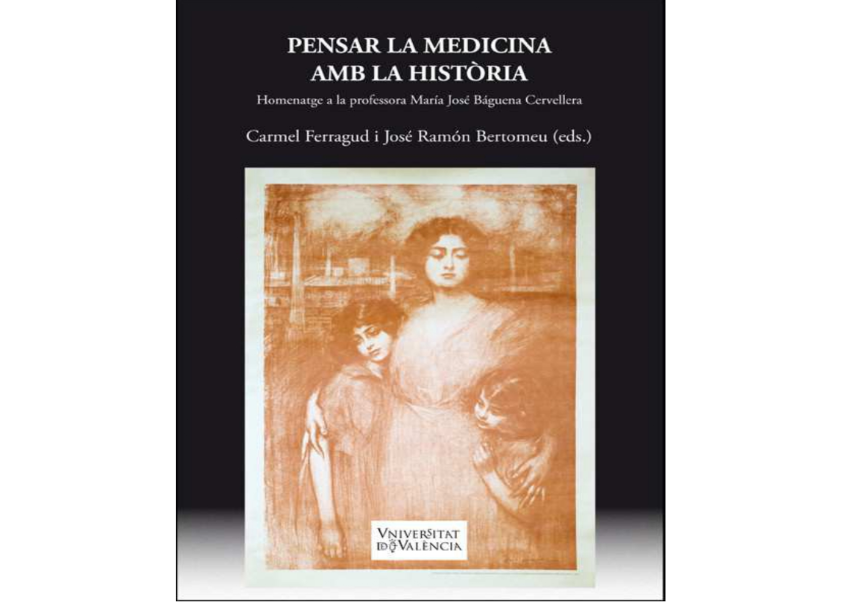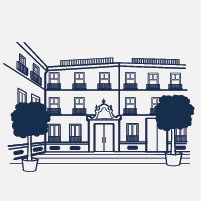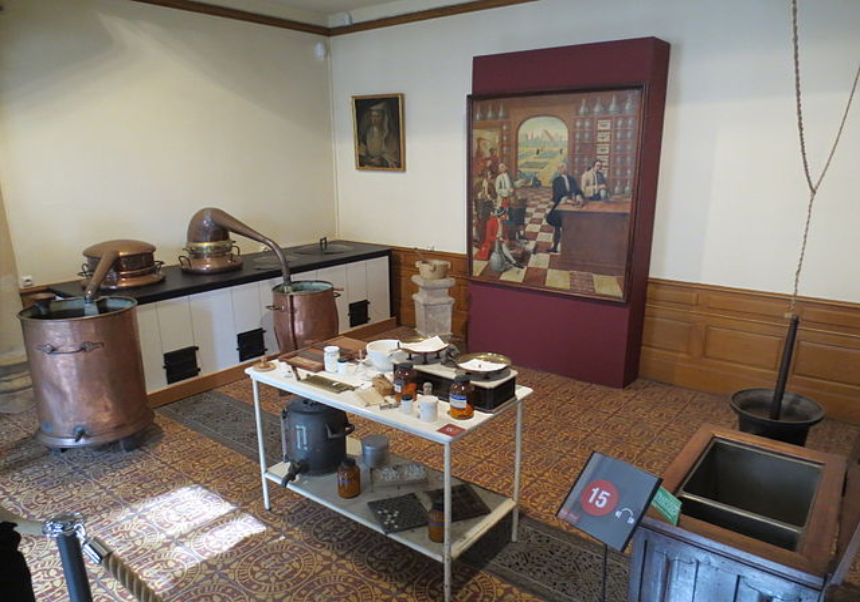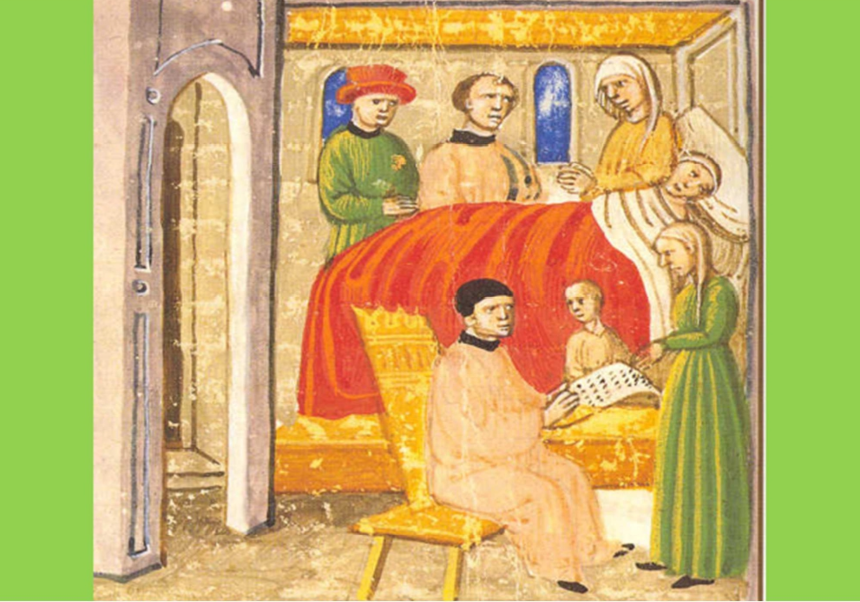
29/09/23
Biblioteca tancada les vesprades del 10 i 11 d'octubre
La Sala d'Investigadors de la Biblioteca Historicomèdica romandrà tancada les vesprades dels propers 10 i 11 d'octubre.
La Sala d'Estudi mantindrà el seu horari habitual.
Disculpeu les molèsties.

06/09/23
The UV Publications Service has just published the book Pensar la medicina con la historia. Homenaje a la professor María José Báguena Cervellera, edited by Carmel Ferragud and José Ramón Bertomeu.
Sixteen researchers, many of them members of the López Piñero Interuniversity Institute, have collaborated in this volume that pays tribute to Professor María José Báguena, who was a member of the Institute since its foundation, as well as a lecturer in the Department of History of Science and Documentation for many years. The book reflects the changes that the history of medicine has undergone during the last decades. The topics, characters and spaces have been expanded. New sources have been introduced, the number of professionals has increased and the educational itineraries have also broadened, both from the area of biomedicine and from history, anthropology or sociology. Finally, and partly as a result of these changes, new readerships have emerged, from health personnel and medical students to patient associations, activist groups and the general public.
Professor María José Báguena Cervellera (1956-2021) has been a prominent witness and protagonist of all these changes throughout more than forty years of full dedication to the history of medicine. His works have revolved around topics such as the history of diseases, epidemics, vaccines, hygiene or Valencian medicine, among many others. These issues can be traced in the chapters of this collective book, which is the continuation of a long dialogue between the authors and Professor Báguena.
The book thus offers an overview of the new trends in the history of medicine, which María José Báguena contributed to promoting with a large number of academic publications, supervised theses and multiple teaching and dissemination activities. The authors of these chapters show our recognition and appreciation to our late colleague through small samples of our most recent research. The chapters dialogue with the Valencian historic-medical tradition that Professor Báguena cultivated with the double perspective coming from her intimate knowledge of traditional techniques and the creative assimilation of new historiographic currents. In addition to a small posthumous tribute, this book is also an introduction to the diverse ways of thinking and writing the history of medicine during the first decades of the 21st century.
More details: <https://puv.uv.es/pensar-la-medicina-amb-la-historia.html>

27/07/23
August timetable
• Researchers room and staffed services (loan, consultation, etc.):
From August 1 to 4 and from August 28 to 31:
8:30 am to 2:30 pm.
July 31 and September 1 the room will remain closed in the afternooon.
• Study room:
From August 1 to 4 and from August 28 to 31:
8:00 am to 8:00 pm.
You can also see the summer timetable at the rest of libraries.

27/07/23
NEW ENTRY TO "SABERES EN ACCIÓN " (KNOWLEDGE IN ACTION): "La triaca, la reina de las medicinas" (Theriac, queen of medicines) by Carmel Ferragud (IILP-UV)
Second part of "saberes en acción" (knowledge in action): https://sabersenaccio.iec.cat/.
Category "The drug in medical galenism".
The most popular medicinal remedy in the history of the West, before the pharmaceutical industry.
Triaca has undoubtedly been the most popular and longest used medicine in the history of the West, from the 1st century to the beginning of the 20th century. Although in Hellenistic times there were numerous compounds called "triacca", antidotes that were effective against the bites and stings of various animals, the creation of the "great triacca" is attributed to Andromachus, physician to the Emperor Nero (54-68). This was composed from the previous known ingredients, about eighty, and the addition of viper meat, original contribution of the imperial doctor, prepared in the form of trociscos.
Galè de Pèrgam (129-207), a key reference in Western medicine, was a great enthusiast of the triaca, to which he dedicated two treatises. These texts were transmitted to the Byzantine, Syriac and Arabic world through various translations, most of which have been lost. Undoubtedly, we owe to the latter Arab tradition its richest, most varied and complex contribution, since they added theoretical reflection and their experience to provide new recipes according to the benefits and risks of their occasional or regular use, the ingredients to be used or the principles underlying their efficacy. For the Islamic world, triaca became an inaccessible and expensive panacea, since many of its ingredients had to come from far away; it was rather consumed by kings, as it had been by emperors in Antiquity. We have no news of triaca during the High Middle Ages in the Latin West and it will be necessary to wait until the 11th century for it to occupy a relevant place in the therapeutic arsenal and the theoretical reflection of physicians. Thanks to translations from Arabic into Latin and the intensification of trade of the Italian republics with the East, access to the remedy will be possible.
To continue reading:https://sabersenaccio.iec.cat/la-triaga-la-reina-de-les-medicines/

18/07/23
NEW ENTRY TO “SABERES EN ACCIÓN” (KNOWLEDGE IN ACTION): "Los apotecarios como productores y dispensadores de medicamentos” (Apothecaries as producers and dispensers of medicines) by Carles Vela Aulesa (Universitat de Barcelona)
Second part of "saberes en acción" (knowledge in action): https://sabersenaccio.iec.cat/.
Category "Medicines in medical galenism".
Spaces and protagonists in the manufacture of galenical medicines in medieval times.
“Com en lo dit hospital sia stada construhida e ordonada una casa o obrador d’especiayria, e aquesta casa o obrador necessàriament se haja a comanar a una persona àbil en l’art d’especiayria, per fer exerops, conserves, compostes de materials e totes altres coses medecinals.”
(Translation into English: "Given that in said hospital a house or workshop of spices has been built and ordered, and this house or workshop must necessarily be entrusted to a person skilled in the art of spices, to make syrups, preserves, compounds and all kinds of medicinal things").
Ordinacions de l'Hospital de la Santa Creu de Barcelona (1417)
Were medieval spice merchants and apothecaries the main producers and dispensers of medicines? It is really difficult to answer this question. The sources show us that there was an important tradition of domestic medicine, of home-made remedies for the most common ailments. It should not be forgotten that then, as still now, the first instance of health care was found in the home, in the family, very often in their women, who treasured an ancient empirical knowledge of "natural" treatments and remedies. There is also documented the existence of a medicine of healers, of people without formal training, but who knew the properties of plants and other substances. These healers were not only used by the popular classes, but sometimes even by monarchs, if the healer had a good reputation. Finally, there is evidence of the use of cures linked to religion: among the records of notaries, it is not uncommon to find from time to time a recipe written down for the use of the family, but even more frequent are those of the notaries it is not uncommon to find from time to time a recipe written down for the family's use, but even more frequent are the ensalmos, prayers intended to cure "diseases" as diverse as intestinal worms or lust.
All these other ways of obtaining remedies are known to have existed, but because of their private or alternative character they have left a small and difficult to trace trail. On the other hand, the existence of spice merchants and apothecaries and their dedication to the production of medicines is well documented, which allows us to know many details of the operation of their workshops.
To continue reading:
https://sabersenaccio.iec.cat/els-apotecaris-com-a-productors-i-dispensadors-de-medicaments/

06/07/23
NEW ENTRY TO "SABERES EN ACCIÓN" (KNOWLEDGE IN ACTION): "El medicamento escrito" (the written medication) by Lluís Cifuentes Comamala (Universitat de Barcelona)
Second part of "saberes en acción" (knowledge in action): https://sabersenaccio.iec.cat/.
Category "Literature".
Texts for learning and managing the world of medicine at the beginning of the current medical system.
The Hippocratic-Galenic medical doctrine, or Galenism, in force in the Western world from Greco-Roman antiquity until the 19th century, articulated theoretical and practical knowledge about what is currently called pharmacy, which, despite coexisting with other knowledge, was the one that had the scientific and academic consideration throughout that period. This knowledge, which received the names of materia medica and apothecary, was dominated by physicians (physicists and surgeons) and, in particular, by apothecaries, the professionals specifically dedicated to the preparation and sale of medicines. As is the case today, apothecaries also sold other products such as, for example, candles, paper, confectionery, wafers or nougat and, above all, spices, which had a dual use, medicinal and culinary, which explains the name "spice merchants" by which they were also known.
To continue reading:





























